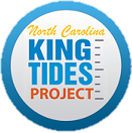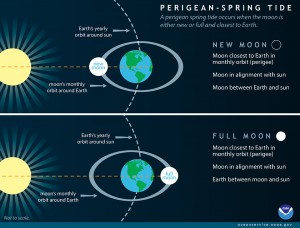What is a king tide?
Define King Tide:
A king tide is a non-scientific term used to describe the predicted highest high-tide and lowest low-tide events of the year. King tides occur during a perigean (when Moon is closest to Earth) spring tide (full and new moon); in other words, a full or new moon must co-occur when the Moon is closest to Earth in its elliptical orbit. Due to their astronomical nature, king tides are regular and predictable events, reoccurring multiple times a year (click here to see the 2018 NC King Tides Calendar).
These king tide events are important because they show what average water levels might look like in the future based on sea-level rise projections. As water levels rise along the coastline, high tides can extend further inland and lead to local flooding. This is of particular concern when a king tide occurs under storm conditions, causing extreme storm surges that can lead to significant damage to property and coastline.
How tides work:
The Moon and Sun both apply gravitational pull on the Earth’s oceans. The ocean responds to the gravitation pull of the Sun and Moon by “bulging” on both the side of the Earth that faces the Sun/Moon and the side directly opposite. These bulges are what create daily high tides as Earth rotates.
Like most coastal areas, North Carolina experiences two high, and two low tide events every lunar day. A lunar day is the time is takes for a specific point on Earth to complete a full rotation in relation to the moon. Unlike the 24-hour solar day that we are all familiar with, a lunar day is 24-hours and 50-minutes. The means that a high tide occurs every 12-hours and 25-minutes. This is why high and low tides occur at different times every day.
The Earth and the moon both have elliptical orbits, which means that the distance between the moon, Earth, and sun is constantly changing. When the sun and moon align, so as to be tugging from the same direction, and the Earth and moon are positioned at the closest points in their orbits, the gravitational pull becomes strongest causing times of greater tidal extremes.
Here are some helpful definitions:
- Syzygy– Linear alignment of the sun, moon, and Earth, which occurs during the new and full moon, causes the respective gravitational pulls of the sun and moon to reinforce each other.
- Spring Tide– The effect of syzygy causes an increase in the tidal range.
- Perigee– Occurs when the moon reaches the closest point to the Earth during its elliptical orbit.
- Perigean Spring Tide– Occurs when the moon is closest to the Earth during a spring tide.
- Perihelion– Occurs when the Earth is closest to the sun in its elliptical orbit.
Twice a year when the earth, sun, and moon line up, when the moon and the sun are at perigee and perihelion, we generally experience the greatest tidal ranges of the year. These resulting tides have informally been dubbed KING TIDES.
For more information check out NOAA’s Tides & Currents Education page

